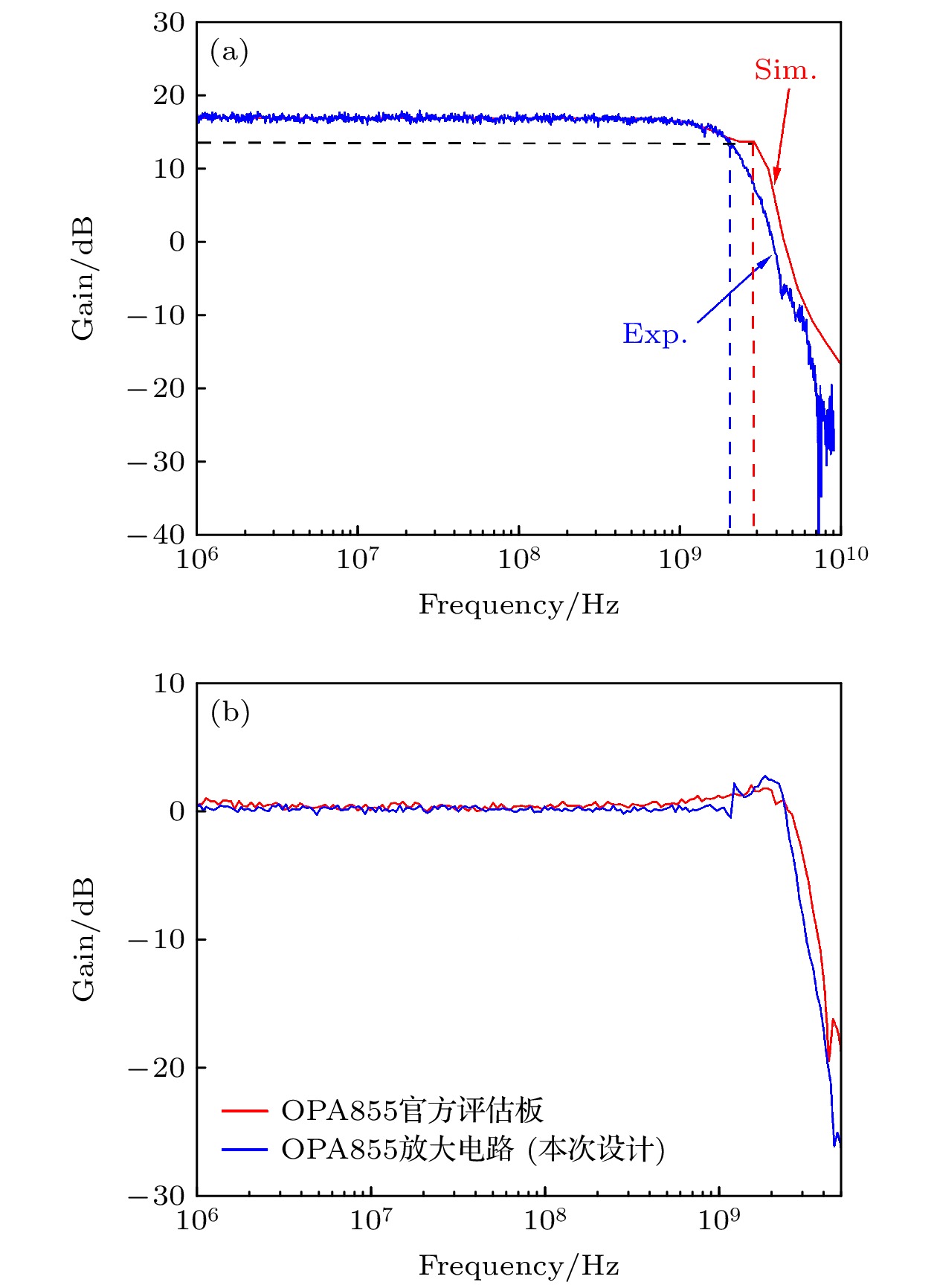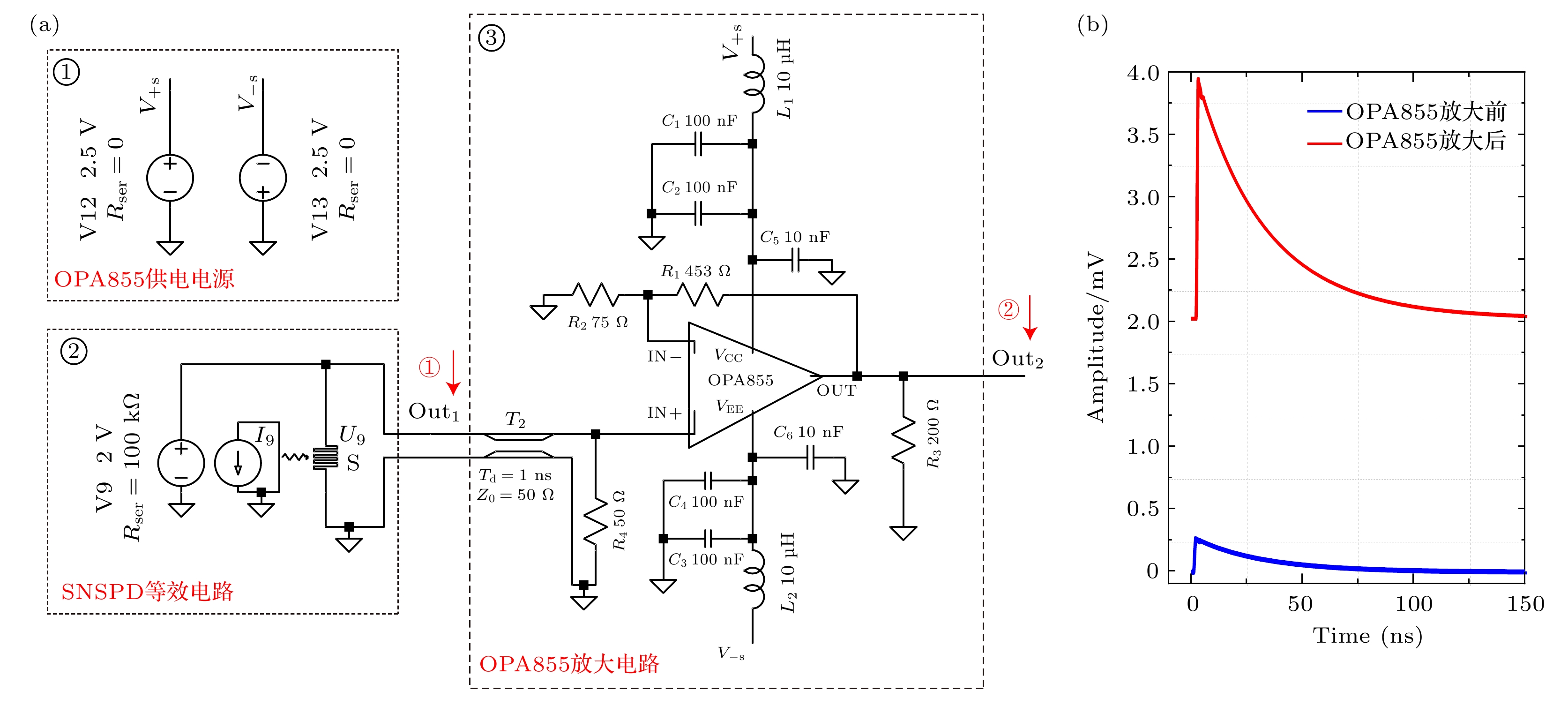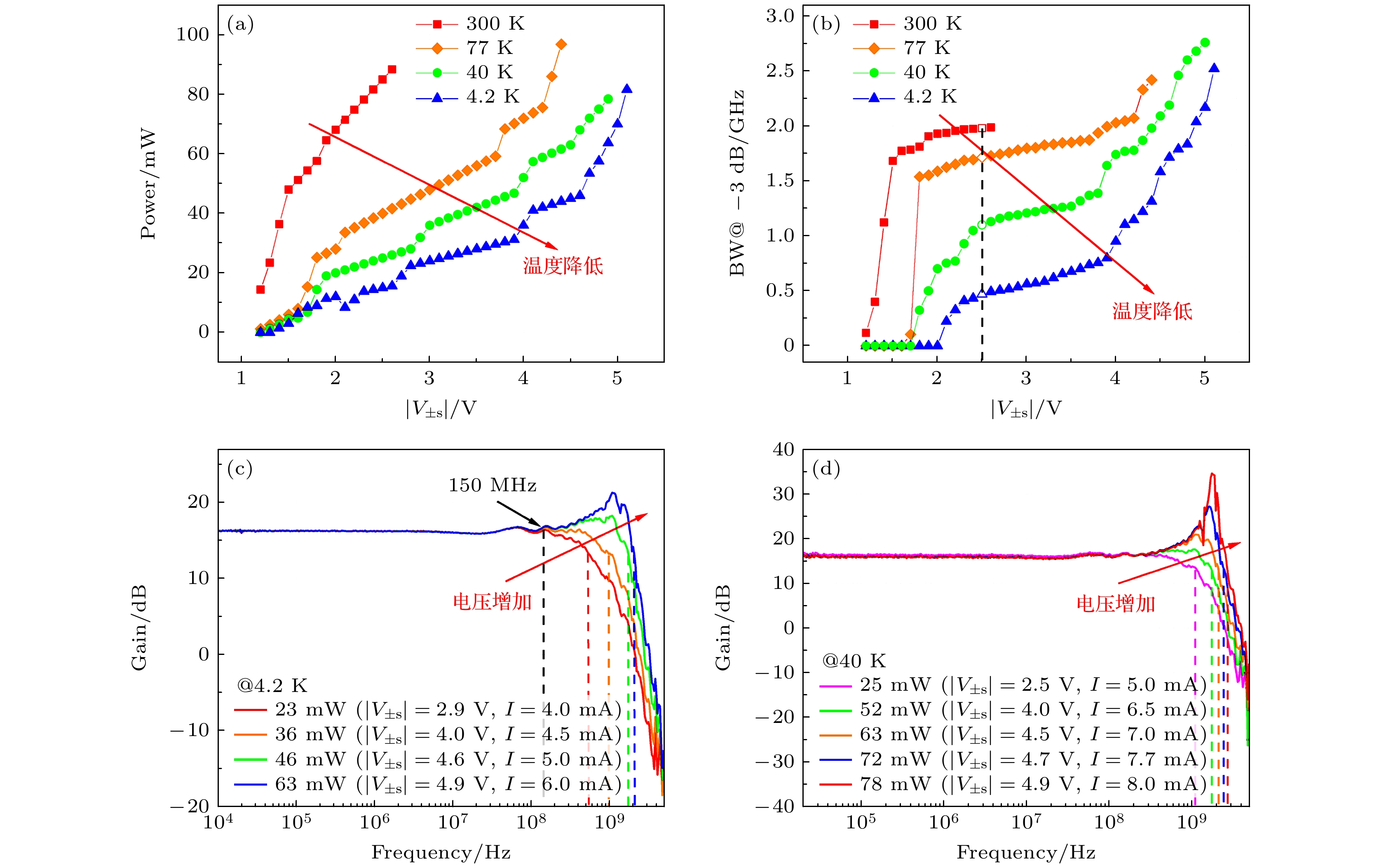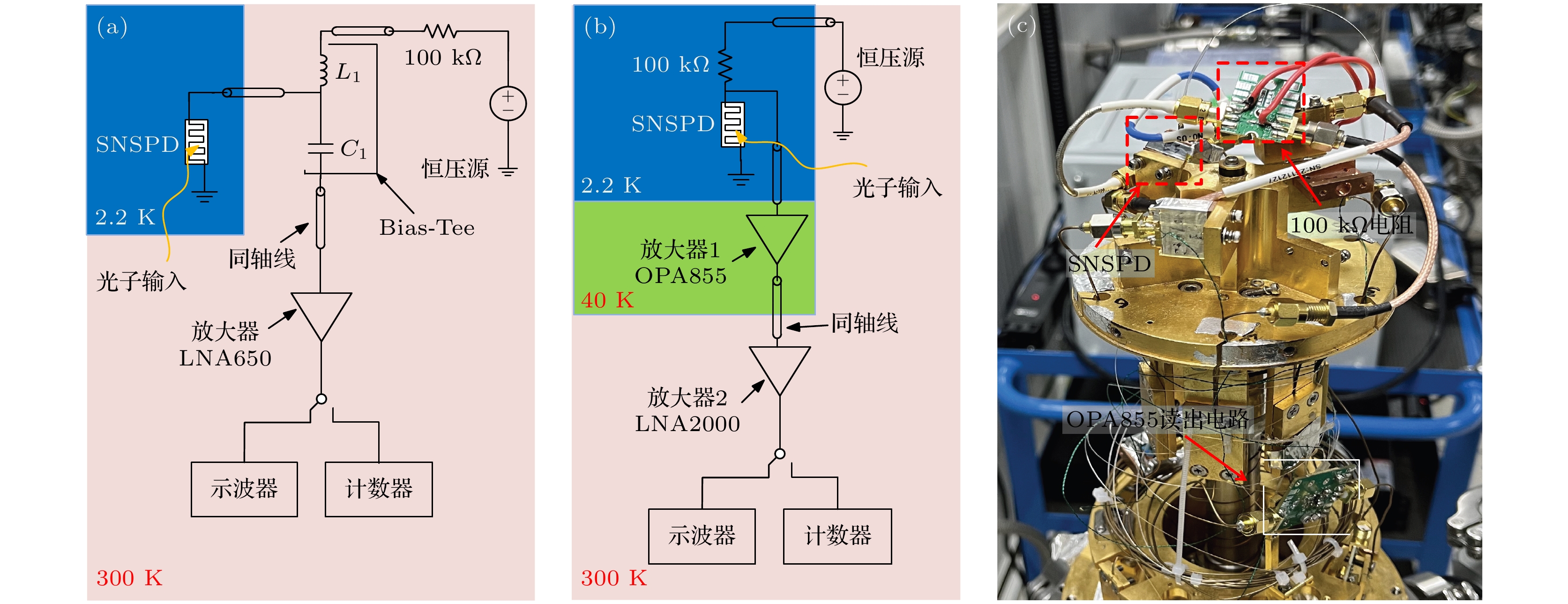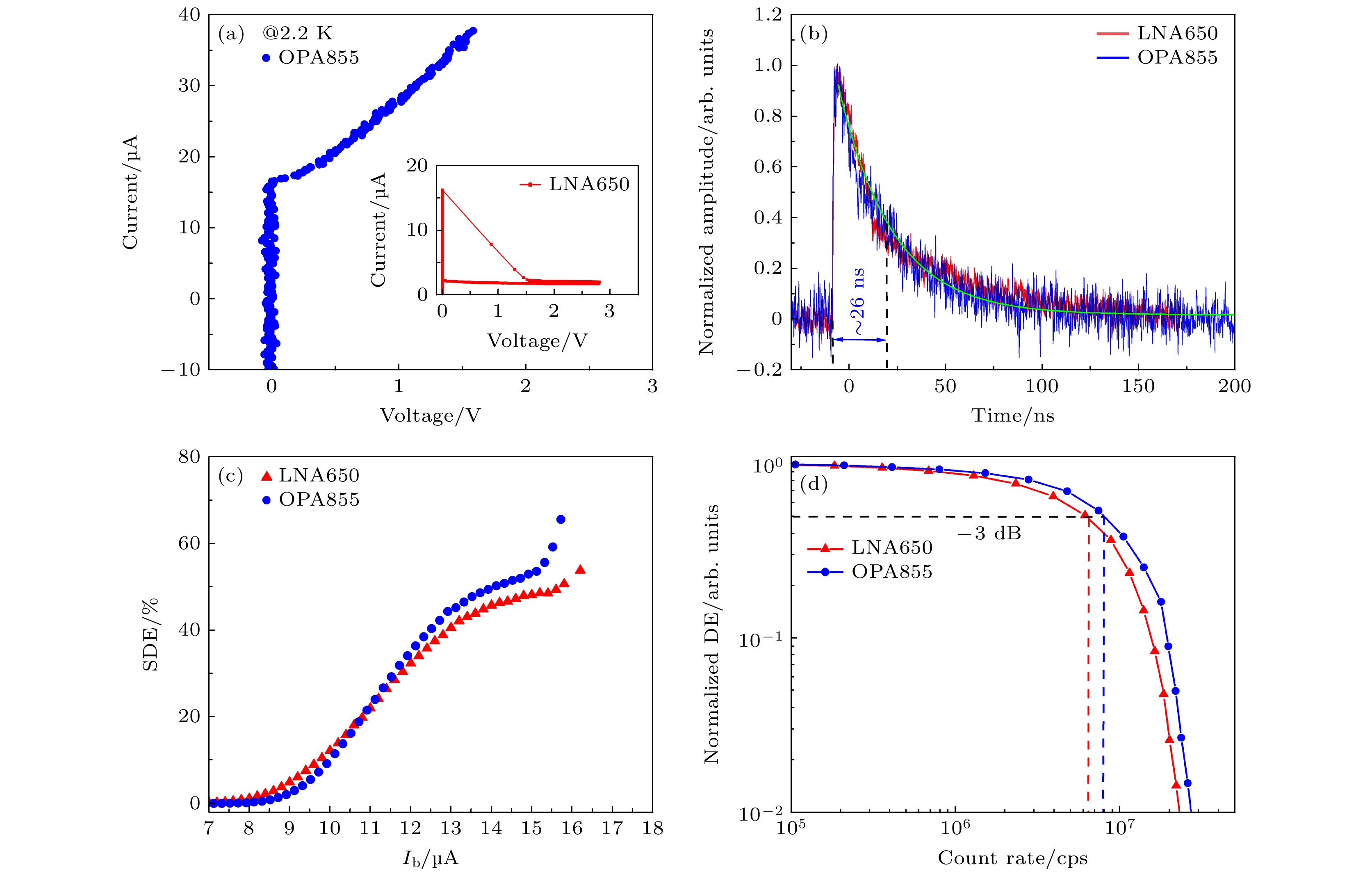-
超导纳米线单光子探测器(SNSPD)具有高计数率、高探测效率和低暗计数等优点, 在光量子通信、光量子计算、激光测距与成像等领域发挥着重要作用. SNSPD的最大计数率(探测速度)会受前级读出电路的影响, 为了提升最大计数率, 通常需要使用一个宽带宽的低温直流耦合读出电路. 本文报道了基于商用高速运算放大芯片OPA855搭建的SNSPD低温直流耦合放大读出电路, 系统表征了该电路从室温300 K到低温4.2 K下的性能参数. 通过提升OPA855的工作电压, 解决了电路在低温下带宽损失的问题. 进一步, 将OPA855放大电路安装在40 K温区, 使用其实现了SNSPD探测性能的实验评估. 相对于常规室温交流耦合电路, SNSPD的最大计数率约提升了1.3倍. 本研究可为OPA855芯片在高速SNSPD等低温领域提供相关参考信息.
-
关键词:
- 运算放大器 /
- 低温读出电路 /
- 直流耦合 /
- 超导纳米线单光子探测器
Superconducting nanowire single-photon detectors (SNSPD) have the advantages of high maximal counting rate (MCR), high detection efficiency, and low dark count rate. They play an important role in the fields of optical quantum communication, optical quantum computing, laser ranging, and imaging. The MCR (i.e. detection speed) of SNSPD can be affected by the front-end readout circuit. To increase MCR, it is usually necessary to use a cryogenic DC-coupled readout circuit with a broad bandwidth. This study reports an SNSPD cryogenic DC-coupled amplification readout circuit based on a commercial high-speed operational amplifier chip OPA855. We systematically characterize its performance parameters in a temperature range from a room temperature of 300 K to a low temperature of 4.2 K. We address the problem of bandwidth loss of the circuit in a low-temperature environment by increasing the operating voltage of the OPA855 chip. For example, at 40 K, the operating voltage increases from ±2.5 V to ±4.9 V, and the quiescent current is about 8 mA, which is equivalent to a power consumption of 78 mW; meanwhile, the gain of this readout circuit is 16.7 dB, and the –3 dB cutoff bandwidth is ~2.7 GHz. We further install a cryogenic DC-coupled readout circuit based on the OPA855 amplifier at 40 K and characterize the performance parameters of the SNSPD at 2.2 K, such as the switching current, system detection efficiency, and MCR. The comparison with the conventional AC-coupled readout circuit at room temperature shows that the MCR increases about 1.3 times after using the DC-coupling circuit. Our study provides the interesting information about the OPA855 amplifier’s performance at low temperatures which facilitates its application in cryogenic environments and related fields.-
Keywords:
- operational amplifier /
- cryogenic readout electronics /
- DC coupling /
- superconducting nanowire single photon detector
[1] Liu Y, Zhang W J, Jiang C, Chen J P, Zhang C, Pan W X, Ma D, Dong H, Xiong J M, Zhang C J, Li H, Wang R C, Wu J, Chen T Y, You L X, Wang X B, Zhang Q, Pan J W 2023 Phys. Rev. Lett. 130 210801
 Google Scholar
Google Scholar
[2] Zhong H S, Wang H, Deng Y H, Chen M C, Peng L C, Luo Y H, Qin J, Wu D, Ding X, Hu Y, Hu P, Yang X Y, Zhang W J, Li H, Li Y X, Jiang X, Gan L, Yang G W, You L X, Wang Z, Li L, Liu N L, Lu C Y, Pan J W 2020 Science 370 1460
 Google Scholar
Google Scholar
[3] Guan Y Q, Li H C, Xue L, Yin R, Zhang L B, Wang H, Zhu G H, Kang L, Chen J, Wu P H 2022 Opt. Lasers Eng. 156 107102
 Google Scholar
Google Scholar
[4] Zhang X Y, Zhang W J, Zhou H, Zhang X F, You L X, Li H, Fan D H, Pan Y M, Yu H Q, Li L Y, Wang Z 2022 IEEE J. Sel. Top. Quantum Electron. 28 3803708
 Google Scholar
Google Scholar
[5] Hu N, Meng Y, Zou K, Feng Y F, Hao Z F, Steinhauer S, Gyger S, Zwiller V, Hu X L 2022 Optica 9 346
 Google Scholar
Google Scholar
[6] 周飞, 陈奇, 刘浩, 戴越, 魏晨, 袁杭, 王昊, 涂学凑, 康琳, 贾小氢, 赵清源, 陈健, 张蜡宝, 吴培亨 2024 物理学报 73 068501
 Google Scholar
Google Scholar
Zhou F, Chen Q, Liu H, Dai Y, Wei C, Yuan H, Wang H, Tu X C, Kang L, Jia X Q, Zhao Q Y, Chen J, Zhang L B, Wu P H 2024 Acta Phys. Sin. 73 068501
 Google Scholar
Google Scholar
[7] Gol’tsman G N, Okunev O, Chulkova G, Lipatov A, Semenov A, Smirnov K, Voronov B, Dzardanov A, Williams C, Sobolewski R 2001 Appl. Phys. Lett. 79 705
 Google Scholar
Google Scholar
[8] Zhang W J, You L X, Li H, Huang J, Lü C L, Zhang L, Liu X Y, Wu J J, Wang Z, Xie X M 2017 Sci. China-Phys. Mech. Astron. 60 120314
 Google Scholar
Google Scholar
[9] Marsili F, Verma V B, Stern J A, Harrington S, Lita A E, Gerrits T, Vayshenker I, Baek B, Shaw M D, Mirin R P, Nam S W 2013 Nat. Photonics 7 210
 Google Scholar
Google Scholar
[10] Korzh B, Zhao Q Y, Allmaras J P, Frasca S, Autry T M, Bersin E A, Beyer A D, Briggs R M, Bumble B, Colangelo M, Crouch G M, Dane A E, Gerrits T, Lita A E, Marsili F, Moody G, Peña C, Ramirez E, Rezac J D, Sinclair N, Stevens M J, Velasco A E, Verma V B, Wollman E E, Xie S, Zhu D, Hale P D, Spiropulu M, Silverman K L, Mirin R P, Nam S W, Kozorezov A G, Shaw M D, Berggren K K 2020 Nat. Photonics 14 250
 Google Scholar
Google Scholar
[11] Zhang W J, Huang J, Zhang C J, You L X, Lü C L, Zhang L, Li H, Wang Z, Xie X M 2019 IEEE Trans. Appl. Supercond. 29 2200204
 Google Scholar
Google Scholar
[12] Dauler E A, Grein M E, Kerman A J, Marsili F, Miki S, Nam S W, Shaw M D, Terai H, Verma V B, Yamashita T 2014 Opt. Eng. 53 081907
 Google Scholar
Google Scholar
[13] 马璐瑶, 张兴雨, 舒志运, 肖游, 张天柱, 李浩, 尤立星 2022 物理学报 71 158501
 Google Scholar
Google Scholar
Ma L Y, Zhang X Y, Shu Z Y, Xiao Y, Zhang T Z, Li H, You L X 2022 Acta Phys. Sin. 71 158501
 Google Scholar
Google Scholar
[14] Kerman A J, Rosenberg D, Molnar R J, Dauler E A 2013 J. Appl. Phys. 113 144511
 Google Scholar
Google Scholar
[15] Zhao Q Y, Jia T, Gu M, Wan C, Zhang L B, Xu W W, Kang L, Chen J, Wu P H 2014 Opt. Lett. 39 1869
 Google Scholar
Google Scholar
[16] Tan J R, Li H C, Zhang L B, Ji T H, Li H, Fei Y, Zhang B, Guo S Y, Guan Y Q, Chen Q, Tu X C, Zhao Q Y, Jia X Q, Chen J, Kang L, Wu P H 2023 Appl. Phys. Lett. 123 142601
 Google Scholar
Google Scholar
[17] Weinreb S, Bardin J C, Mani H 2007 IEEE Trans. Microw. Theory Tech. 55 2306
 Google Scholar
Google Scholar
[18] Shan W L, Yang J, Shi S C, Yao Q J, Zuo Y X, Lin Z H, Chen S H, Zhang X G, Duan W Y, Cao A Q, Li S, Li Z Q, Liu J, Zhong J Q 2012 IEEE Trans. Terahertz Sci. Technol. 2 593
 Google Scholar
Google Scholar
[19] Zhang W, Gao J R, Hajenius M, Miao W, Khosropanah P, Klapwijk T M, Shi S C 2011 IEEE Trans. Terahertz Sci. Technol. 1 378
 Google Scholar
Google Scholar
[20] Bardin J 2022 Beyond-Classical Computing Using Superconducting Quantum Processors IEEE International Solid-State Circuits Conference (ISSCC) San Francisco, CA, USA, 422
[21] Le Guevel L, Billiot G, Paz B C, Tagliaferri M L V, De Franceschi S, Maurand R, Cassé M, Zurita M, Sanquer M, Vinet M, Jehl X, Jansen A G M, Pillonnet G 2020 Appl. Phys. Rev. 7 041407
 Google Scholar
Google Scholar
[22] Sadrozinski H F W, Seiden A, Cartiglia N 2018 Rep. Prog. Phys. 81 026101
 Google Scholar
Google Scholar
[23] D'Incecco M, Galbiati C, Giovanetti G K, Korga G, Li X R, Mandarano A, Razeto A, Sablone D, Savarese C 2018 IEEE Trans. Nucl. Sci. 65 1005
 Google Scholar
Google Scholar
[24] Geng X, Luo S Y, Li L, Chen Q, Sun M 2021 Opt. Quantum Electron. 53 687
 Google Scholar
Google Scholar
[25] Ge J J, Li C H, Zhang D, Yang Y F, Wang A N, Yang X, Liang H, Liu Y W 2022 Nucl. Instrum. Methods Phys. Res. Sect. A-Accel. Spectrom. Dect. Assoc. Equip. 1040 167222
 Google Scholar
Google Scholar
[26] Cahall C T 2019 Ph. D. Dissertation (America: Duke University
[27] Texas instruments. https://www.ti.com.cn/cn/lit/ds/symlink/opa855.pdf [2018-07]
[28] Kerman A J, Dauler E A, Keicher W E, Yang J K W, Berggren K K, Gol’tsman G, Voronov B 2006 Appl. Phys. Lett. 88 111116
 Google Scholar
Google Scholar
[29] Franco S 2002 Design with Operational Amplifiers and Analog Integrated Circuits (Vol. 1988) (McGraw-Hill New York
[30] Texas instruments. https://www.ti.com.cn/cn/lit/ds/symlink/opa855IDSGEVM.pdf
[31] Berggren K K, Zhao Q Y, Abebe N, Chen M J, Ravindran P, McCaughan A, Bardin J C 2018 Supercond. Sci. Technol. 31 055010
 Google Scholar
Google Scholar
[32] Rumiantsev A, Ridler N 2008 IEEE Microw. Mag. 9 86
 Google Scholar
Google Scholar
[33] Bardin J C 2009 Ph. D. Dissertation (California Institute of Technology
[34] Zhang W J, Xu G Z, You L X, Zhang C J, Huang H, Ou X, Sun X Q, Xiong J M, Li H, Wang Z, Xie X M 2021 Opt. Lett. 46 1049
 Google Scholar
Google Scholar
-
图 1 (a) 基于 OPA855芯片的放大电路原理图; (b) 电路板的实物照片, Vin为信号输入端口, Vout为信号输出端口, V+s是正电压供电端口, V–s是负电压供电端口
Fig. 1. (a) Schematic diagram of an amplification circuit based on the OPA855 chip; (b) photo of the circuit board, where Vin is the signal input port, Vout is the signal output port, V+s is the positive voltage power supply port, and V–s is the negative voltage power supply port.
图 2 (a) 仿真(Sim.)和室温测试(Exp.)的增益-频率关系的对比图; (b) 室温下 OPA855评估板(德州仪器)与本设计的测量结果对比
Fig. 2. Comparison of the gain-frequency relationship between simulation (Sim.) and room temperature experiment (Exp.); (b) comparison of measurement results between OPA855 evaluation board (Texas Instruments) and this design at room temperature.
图 3 (a) SNSPD 等效电路与OPA855读出电路级联的仿真电路图; 其中虚线框1中为OPA855供电电源模块, 虚线框2中为SNSPD 的等效电路模块, 其中“U9”表示SNSPD的等效元件; 虚线框3中为OPA855读出电路模块; (b) SNSPD输出脉冲进入OPA855放大器前/后的仿真结果对比, 其中“放大前”、“放大后”的脉冲信号监测位置分别由图(a)中的箭头1, 2指示(Out1, Out2)
Fig. 3. (a) Simulation circuit diagram of the SNSPD equivalent circuit connected with the OPA855 readout circuit; the dotted box 1 is the power module that supplies the OPA855, and the dotted box 2 is the SNSPD equivalent circuit module, where “U9” represents the SNSPD equivalent component, the dotted box 3 shows the OPA855 readout circuit module; (b) comparison of simulation results before and after the SNSPD output pulse enters the OPA855 amplifier, the pulse signal monitoring positions of “before amplification” and “after amplification” are shown by arrows 1 and 2 (marked Out1 and Out2) in panel (a).
图 4 (a) SOLT校准件3D示意图, 其中S表示短路端口, O表示开路端口, L表示负载端口, T表示直通端口, In为信号输入端口, OUT为信号输出端口, V+s为正供电电压, V–s为负供电电压; (b) 校准件安装在2 K冷台的照片; (c) SOLT校准实验的设备连接示意图
Fig. 4. (a) 3D schematic diagram of the SOLT calibration component, where S represents the short-circuit port, O represents the open-circuit port, L represents the load port, T represents the straight-through port, In is the signal input port, OUT is the signal output port, V+s is positive supply voltage port, V–s is the negative supply voltage port; (b) photo of the calibration component installed on the 2 K cold stage; (c) equipment connection diagram for the SOLT calibration experiment.
图 5 OPA855放大电路的性能测量结果 (a) 不同温度下, 功耗随电压的变化关系; (b) 不同温度下, 带宽和功耗的变化关系; (c) 相同温度4.2 K下, 增益-频率的函数在不同功耗下的表现; (d) 40 K下, OPA855的增益-频率特性曲线
Fig. 5. Performance measurements of the OPA855 amplifier circuit: (a) Relationship between power consumption and voltage at different temperatures; (b) the relationship between bandwidth and power consumption at different temperatures; (c) gain as a function of frequency at the same temperature of 4.2 K, with different power consumptions; (d) gain-frequency characteristic curve of the OPA855 circuit at 40 K.
图 6 SNSPD器件光-电测试系统示意图 (a) LNA650交流耦合读出电路; (b) OPA855直流耦合读出电路; (c) SNSPD与OPA855低温直流耦合读出电路系统的实物照片
Fig. 6. Schematic diagram of the SNSPD device optical-electrical test system: (a) AC coupling readout circuit using LNA650 amplifier; (b) DC coupling readout circuit using OPA855 chip; (c) photos of SNSPD and cryogenic DC coupling readout circuit using OPA855 chip.
图 7 直流耦合模式(OPA855)与交流耦合模式(LNA650)下, 对同一SNSPD性能进行测量的结果对比 (a) 2.2 K下, I-V曲线的测量结果, 主图为OPA855直流耦合读出电路, 插图为常规交流耦合电路; (b)归一化后的读出脉冲波形对比, 其中OPA855的输出脉冲经过了室温二级放大; (c) 系统探测效率随偏置电流曲线的对比; (d)归一化的探测效率随计数率变化的结果对比, 其中竖直虚线所对应的横坐标为效率下降–3 dB时所对应的计数率值
Fig. 7. Comparison of measurement results of the same SNSPD performance in DC coupling (OPA855) and AC coupling (LNA650): (a) I-V curves measured at 2.2 K, the main picture shows the OPA855 DC coupling readout circuit and the inset shows the result measured by the AC coupling circuit; (b) normalized readout pulses, in which the output pulse of the OPA855 is further amplified by the secondary amplifier at room temperature; (c) system detection efficiency versus bias current curves; (d) normalized detection efficiency versus the count rate, the vertical dotted line is the corresponding count rate value when the normalized detection efficiency drops to –3 dB (0.5 times) of its original value.
表 1 OPA855芯片主要参数
Table 1. Main performance parameters of an OPA855 chip.
增益带宽积
GBW/GHz最低稳定增益
Av/V/V开环增益
α/ dB差模输入阻抗
rd/kΩ共模输入阻抗
rc/MΩ闭环输出阻抗
ro/Ω静态电流
Iqu/mA8 ~7 76 5 2.3 0.15 17.8 表 2 使用的外部电子元件参数及其在不同温度下的性能
Table 2. Parameters of external electronic components used and their performance at room and low temperatures.
元件类型/单位 符号 室温(300 K)测量值 低温(2.2 K)测量值 变化率/% 型号 品牌 电容/nf C1, C2, C3, C4 100 102 2.0 C0 G 1206 村田 C5, C6 10 10 ~0 C0 G 0603 薄膜电阻/Ω R1 453 455 0.4 0603 松下 R2 75 76 1.3 R3 200 203 1.5 R4 50 51 2.0 磁珠 L1, L2 — — — 0603 村田 OPA855 — — — — WSON8 德州仪器 -
[1] Liu Y, Zhang W J, Jiang C, Chen J P, Zhang C, Pan W X, Ma D, Dong H, Xiong J M, Zhang C J, Li H, Wang R C, Wu J, Chen T Y, You L X, Wang X B, Zhang Q, Pan J W 2023 Phys. Rev. Lett. 130 210801
 Google Scholar
Google Scholar
[2] Zhong H S, Wang H, Deng Y H, Chen M C, Peng L C, Luo Y H, Qin J, Wu D, Ding X, Hu Y, Hu P, Yang X Y, Zhang W J, Li H, Li Y X, Jiang X, Gan L, Yang G W, You L X, Wang Z, Li L, Liu N L, Lu C Y, Pan J W 2020 Science 370 1460
 Google Scholar
Google Scholar
[3] Guan Y Q, Li H C, Xue L, Yin R, Zhang L B, Wang H, Zhu G H, Kang L, Chen J, Wu P H 2022 Opt. Lasers Eng. 156 107102
 Google Scholar
Google Scholar
[4] Zhang X Y, Zhang W J, Zhou H, Zhang X F, You L X, Li H, Fan D H, Pan Y M, Yu H Q, Li L Y, Wang Z 2022 IEEE J. Sel. Top. Quantum Electron. 28 3803708
 Google Scholar
Google Scholar
[5] Hu N, Meng Y, Zou K, Feng Y F, Hao Z F, Steinhauer S, Gyger S, Zwiller V, Hu X L 2022 Optica 9 346
 Google Scholar
Google Scholar
[6] 周飞, 陈奇, 刘浩, 戴越, 魏晨, 袁杭, 王昊, 涂学凑, 康琳, 贾小氢, 赵清源, 陈健, 张蜡宝, 吴培亨 2024 物理学报 73 068501
 Google Scholar
Google Scholar
Zhou F, Chen Q, Liu H, Dai Y, Wei C, Yuan H, Wang H, Tu X C, Kang L, Jia X Q, Zhao Q Y, Chen J, Zhang L B, Wu P H 2024 Acta Phys. Sin. 73 068501
 Google Scholar
Google Scholar
[7] Gol’tsman G N, Okunev O, Chulkova G, Lipatov A, Semenov A, Smirnov K, Voronov B, Dzardanov A, Williams C, Sobolewski R 2001 Appl. Phys. Lett. 79 705
 Google Scholar
Google Scholar
[8] Zhang W J, You L X, Li H, Huang J, Lü C L, Zhang L, Liu X Y, Wu J J, Wang Z, Xie X M 2017 Sci. China-Phys. Mech. Astron. 60 120314
 Google Scholar
Google Scholar
[9] Marsili F, Verma V B, Stern J A, Harrington S, Lita A E, Gerrits T, Vayshenker I, Baek B, Shaw M D, Mirin R P, Nam S W 2013 Nat. Photonics 7 210
 Google Scholar
Google Scholar
[10] Korzh B, Zhao Q Y, Allmaras J P, Frasca S, Autry T M, Bersin E A, Beyer A D, Briggs R M, Bumble B, Colangelo M, Crouch G M, Dane A E, Gerrits T, Lita A E, Marsili F, Moody G, Peña C, Ramirez E, Rezac J D, Sinclair N, Stevens M J, Velasco A E, Verma V B, Wollman E E, Xie S, Zhu D, Hale P D, Spiropulu M, Silverman K L, Mirin R P, Nam S W, Kozorezov A G, Shaw M D, Berggren K K 2020 Nat. Photonics 14 250
 Google Scholar
Google Scholar
[11] Zhang W J, Huang J, Zhang C J, You L X, Lü C L, Zhang L, Li H, Wang Z, Xie X M 2019 IEEE Trans. Appl. Supercond. 29 2200204
 Google Scholar
Google Scholar
[12] Dauler E A, Grein M E, Kerman A J, Marsili F, Miki S, Nam S W, Shaw M D, Terai H, Verma V B, Yamashita T 2014 Opt. Eng. 53 081907
 Google Scholar
Google Scholar
[13] 马璐瑶, 张兴雨, 舒志运, 肖游, 张天柱, 李浩, 尤立星 2022 物理学报 71 158501
 Google Scholar
Google Scholar
Ma L Y, Zhang X Y, Shu Z Y, Xiao Y, Zhang T Z, Li H, You L X 2022 Acta Phys. Sin. 71 158501
 Google Scholar
Google Scholar
[14] Kerman A J, Rosenberg D, Molnar R J, Dauler E A 2013 J. Appl. Phys. 113 144511
 Google Scholar
Google Scholar
[15] Zhao Q Y, Jia T, Gu M, Wan C, Zhang L B, Xu W W, Kang L, Chen J, Wu P H 2014 Opt. Lett. 39 1869
 Google Scholar
Google Scholar
[16] Tan J R, Li H C, Zhang L B, Ji T H, Li H, Fei Y, Zhang B, Guo S Y, Guan Y Q, Chen Q, Tu X C, Zhao Q Y, Jia X Q, Chen J, Kang L, Wu P H 2023 Appl. Phys. Lett. 123 142601
 Google Scholar
Google Scholar
[17] Weinreb S, Bardin J C, Mani H 2007 IEEE Trans. Microw. Theory Tech. 55 2306
 Google Scholar
Google Scholar
[18] Shan W L, Yang J, Shi S C, Yao Q J, Zuo Y X, Lin Z H, Chen S H, Zhang X G, Duan W Y, Cao A Q, Li S, Li Z Q, Liu J, Zhong J Q 2012 IEEE Trans. Terahertz Sci. Technol. 2 593
 Google Scholar
Google Scholar
[19] Zhang W, Gao J R, Hajenius M, Miao W, Khosropanah P, Klapwijk T M, Shi S C 2011 IEEE Trans. Terahertz Sci. Technol. 1 378
 Google Scholar
Google Scholar
[20] Bardin J 2022 Beyond-Classical Computing Using Superconducting Quantum Processors IEEE International Solid-State Circuits Conference (ISSCC) San Francisco, CA, USA, 422
[21] Le Guevel L, Billiot G, Paz B C, Tagliaferri M L V, De Franceschi S, Maurand R, Cassé M, Zurita M, Sanquer M, Vinet M, Jehl X, Jansen A G M, Pillonnet G 2020 Appl. Phys. Rev. 7 041407
 Google Scholar
Google Scholar
[22] Sadrozinski H F W, Seiden A, Cartiglia N 2018 Rep. Prog. Phys. 81 026101
 Google Scholar
Google Scholar
[23] D'Incecco M, Galbiati C, Giovanetti G K, Korga G, Li X R, Mandarano A, Razeto A, Sablone D, Savarese C 2018 IEEE Trans. Nucl. Sci. 65 1005
 Google Scholar
Google Scholar
[24] Geng X, Luo S Y, Li L, Chen Q, Sun M 2021 Opt. Quantum Electron. 53 687
 Google Scholar
Google Scholar
[25] Ge J J, Li C H, Zhang D, Yang Y F, Wang A N, Yang X, Liang H, Liu Y W 2022 Nucl. Instrum. Methods Phys. Res. Sect. A-Accel. Spectrom. Dect. Assoc. Equip. 1040 167222
 Google Scholar
Google Scholar
[26] Cahall C T 2019 Ph. D. Dissertation (America: Duke University
[27] Texas instruments. https://www.ti.com.cn/cn/lit/ds/symlink/opa855.pdf [2018-07]
[28] Kerman A J, Dauler E A, Keicher W E, Yang J K W, Berggren K K, Gol’tsman G, Voronov B 2006 Appl. Phys. Lett. 88 111116
 Google Scholar
Google Scholar
[29] Franco S 2002 Design with Operational Amplifiers and Analog Integrated Circuits (Vol. 1988) (McGraw-Hill New York
[30] Texas instruments. https://www.ti.com.cn/cn/lit/ds/symlink/opa855IDSGEVM.pdf
[31] Berggren K K, Zhao Q Y, Abebe N, Chen M J, Ravindran P, McCaughan A, Bardin J C 2018 Supercond. Sci. Technol. 31 055010
 Google Scholar
Google Scholar
[32] Rumiantsev A, Ridler N 2008 IEEE Microw. Mag. 9 86
 Google Scholar
Google Scholar
[33] Bardin J C 2009 Ph. D. Dissertation (California Institute of Technology
[34] Zhang W J, Xu G Z, You L X, Zhang C J, Huang H, Ou X, Sun X Q, Xiong J M, Li H, Wang Z, Xie X M 2021 Opt. Lett. 46 1049
 Google Scholar
Google Scholar
计量
- 文章访问数: 7385
- PDF下载量: 287
- 被引次数: 0













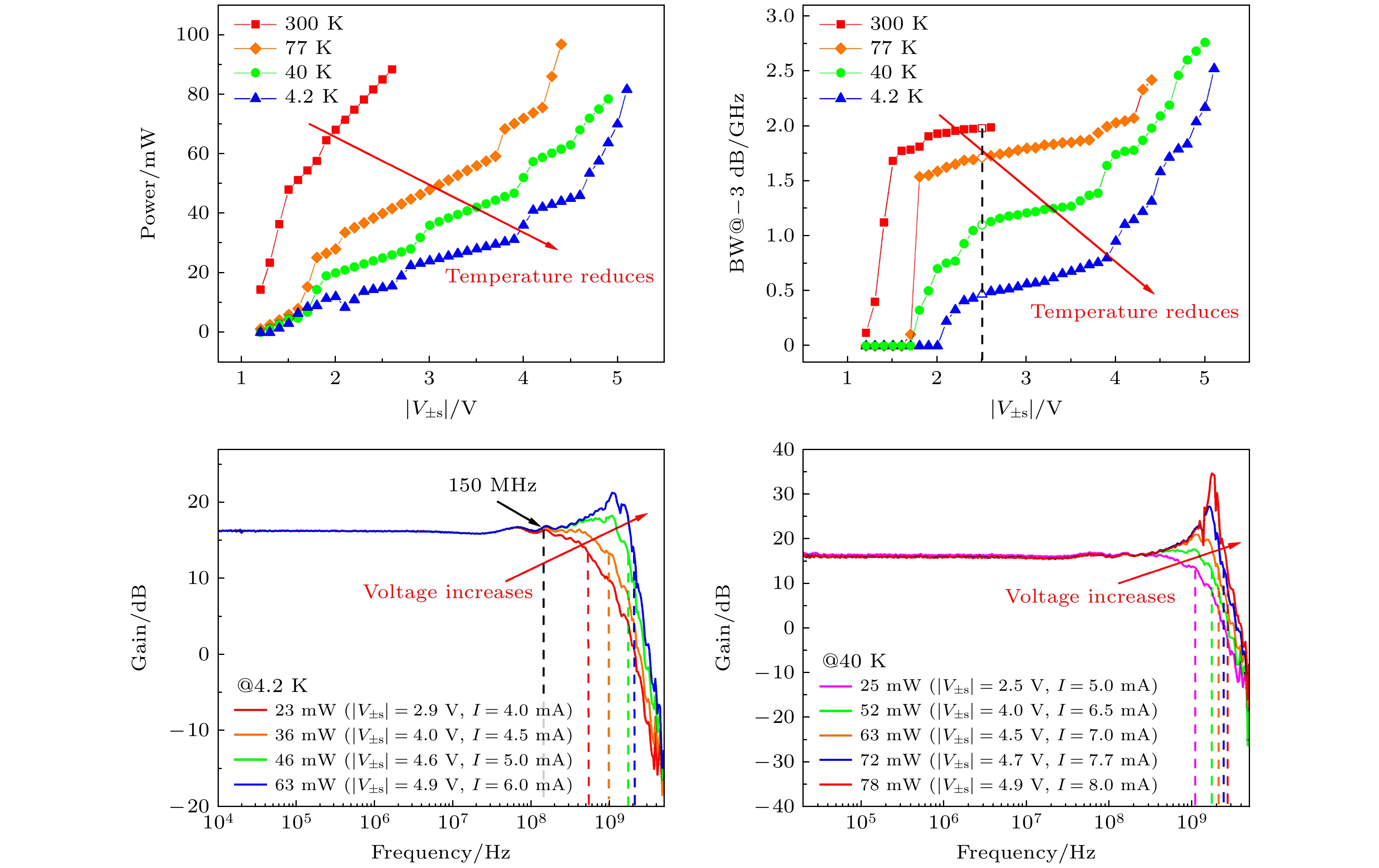

 下载:
下载:
